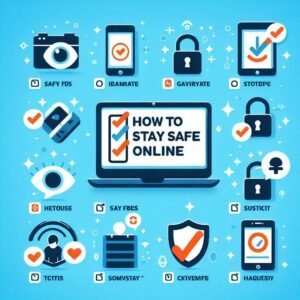What is Hacking and How to Prevent from Hack!

Introduction
We hear about hacking all the time bank breaches, leaked passwords, hacked Instagram accounts. But what exactly is hacking, and how can you protect yourself from it?
This post breaks it down clearly. You will learn what hacking is, how it works, the different types, and most importantly how to protect your digital life from getting hijacked.
What is Hacking?
Hacking is the act of gaining unauthorized access to systems, networks, or data. Sometimes it’s done out of curiosity, sometimes for profit, and sometimes to cause damage.
At its core, hacking is about exploiting vulnerabilities gaps in a system’s armor. That could mean weak passwords, outdated software, unpatched servers, or even human error.
Not all hacking is bad. There are good hackers too (we’ll talk about that shortly), but when people say “my account got hacked,” they usually mean someone broke in without permission.
Types of Hackers
1. Black Hat Hackers
These are the criminals. They hack for personal gain stealing money, data, or identities. Think ransomware gangs and phishing attackers.
2. White Hat Hackers
These are ethical hackers. They work with companies to find and fix security holes before criminals can exploit them.
3. Gray Hat Hackers
Somewhere in between. They might break into a system without permission but don’t do it to cause harm. Often, they’ll report vulnerabilities but their methods still aren’t legal.

Common Hacking Techniques
Understanding how hackers operate is the first step in defending yourself.
1. Phishing
Fake emails or messages that trick you into giving up sensitive info like passwords or credit card numbers.
Example: You get an email that looks like it’s from your bank, asking you to “verify your login.”
2. Malware
Short for malicious software this includes viruses, trojans, spyware, and ransomware. It can infect your device and give attackers control.
3. Brute Force Attacks
Hackers use automated tools to guess your password by trying thousands (or millions) of combinations.
4. Man in the Middle (MitM)
The attacker secretly intercepts communication between two parties—like between you and your bank’s website.
5. SQL Injection
Hackers exploit weakly coded websites to run commands on their databases and steal data.

Real Life Examples of Hacking
Let’s ground this in reality. Here are a few high profile cases:
-
Yahoo Data Breach (2013–14): Over 3 billion accounts compromised. Names, emails, passwords—all leaked.
-
WannaCry Ransomware (2017): A global attack affecting hospitals, governments, and businesses. Systems were locked until ransom was paid in Bitcoin.
-
Facebook Account Hijacks: Millions of personal profiles have been compromised through phishing links or third party apps.
These aren’t just news headlines. These attacks cost companies millions and disrupt lives.
Why Should You Care?
Even if you’re not a tech expert, hacking affects you. Here’s how:
-
Stolen Identity: Your data can be used to open fake bank accounts, get loans, or commit fraud.
-
Financial Loss: Hackers can empty your bank account or max out your credit card.
-
Reputation Damage: A hacked social media account can post damaging content in your name.
-
Privacy Invasion: Personal photos, emails, and chats can be exposed.
Bottom line: your digital life is a goldmine for hackers. You need to protect it.
How to Prevent Getting Hacked
Now for the most important part defense.
1. Use Strong, Unique Passwords
Never reuse passwords across sites. Use a combination of letters, numbers, and symbols.
Better yet, use a password manager like Bitwarden, 1Password, or LastPass.
2. Enable Two Factor Authentication (2FA)
Always turn on 2FA when available. This adds a second layer of protection beyond your password.
Even if a hacker gets your password, they can’t log in without the 2FA code.
3. Keep Software Updated
Old software has vulnerabilities. Keep your OS, apps, and browsers updated regularly.
4. Beware of Phishing
Don’t click on suspicious links or download unknown attachments. Verify the sender even if the message looks official.
If unsure, go directly to the website instead of clicking a link in an email.
5. Install Antivirus and Anti malware Tools
These tools catch and block threats before they do damage. Windows Defender is a decent free option; others include Malwarebytes, Norton, and Bitdefender.
6. Secure Your Wi-Fi
Change the default router password. Use WPA3 encryption if your router supports it. Never use public Wi-Fi without a VPN.
7. Back Up Your Data
Regularly back up important files to the cloud or an external drive. If ransomware hits, you won’t lose everything.
8. Limit App Permissions
Many apps request access to things they don’t need. Review app permissions on your phone and revoke what’s unnecessary.
9. Educate Yourself (and Your Family)
Most hacks succeed due to human error. Learn the basics of cybersecurity and teach your kids and elders too.

Extra Tips for Businesses
If you run a business—even a small one you are a target too. Here is what to do:
-
Conduct regular security audits
-
Use endpoint protection on all devices
-
Educate staff on phishing and social engineering
-
Use firewalls and network segmentation
-
Keep backups off site
-
Monitor for unusual network activity
-
Don’t ignore compliance (GDPR, HIPAA, etc.)
Even one hacked account or compromised employee device can expose your whole operation.

The Human Factor
Let me be clear: technology doesn’t get hacked people do.
Hackers rely on mistakes, assumptions, and laziness. That is why they don’t need supercomputers. All they need is one weak link.
That’s also why no tool can protect you if you don’t understand the basics. It is about behavior more than anything.
So take security seriously not just because you have something to hide, but because you have something to lose.
Final Thoughts
Hacking isn’t going away. In fact, it’s getting more sophisticated by the day. But staying safe doesn’t mean being paranoid it means being smart.
Here is what you should remember:
-
Use strong passwords
-
Turn on 2FA
-
Stay skeptical of links and attachments
-
Keep things updated
-
Learn a little, often
Protect your data like it matters because it does.

